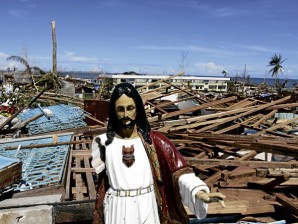Worst yet to come, but ‘Pablo’ survivors start to rise again

A STATUE of Christ is intact amid the ruins in Baganga, Davao Oriental, one of the towns hardest hit by Typhoon “Pablo.” More than 500 people have been killed and scores are missing as the storm cut a wide swath of destruction across Mindanao. JEOFFREY MAITEM
BAGANGA, Davao Oriental—The roads have been cleared of fallen trees and debris. People in Davao Oriental have started to, literally, pick up the pieces of their homes shattered by Typhoon “Pablo” a few weeks ago.
But for Vice Gov. Jose Mayo Almario, it’s still a long way to recovery. “The worst is yet to come,” he said when the Inquirer chanced upon him and his family distributing relief goods through Catholic churches in Baganga and in the towns of Boston and Cateel on Friday.
Almario foresees more hunger among the people of the three towns, which were the hardest hit by the typhoon. “Donations and relief goods will dwindle. What will follow is hunger,” he said.
“Then, the social problems, like theft and illnesses, will rise,” he added.
Fr. Darwey Clark, parish priest of Sacred Heart of Jesus Church in Barangay Lambajon, sees a similar scenario. “They (the residents) may be getting relief goods, but until when?” he asked.
“Most people here do not have a livelihood,” he said, adding that some residents have already left the villages.
Flash flood
Clark warns of an impending calamity—this time, a flash flood—now that the trees are gone. “Those (trees) that withstood Pablo are also dying,” he said, adding that the typhoon brought with it seawater, killing the the remaining trees.
“Without trees to hold rainwater, rivers will swell, there will be flooding,” he said.
Days before Christmas, hours of continuous rain had easily caused rivers to swell, causing panic to still typhoon-traumatized residents.
Almario, however, has a more disastrous scenario.
“There will be flooding, bringing with it felled and uprooted trees, which will destroy more bridges,” the vice governor said.
The Dec. 4 typhoon caused the Manurigao River in Caraga town to swell, with rampaging floodwater bringing in uprooted trees and cut logs that destroyed the Baogo Bridge, which used to connect the towns of Baganga and Caraga. Most relief workers, along with their goods, have to take the eight-hour Surigao del Sur route to reach Boston, Cateel and Baganga.
Looking at the mountains surrounding the town center here, Almario said: “I also fear that when it rains, floodwaters will bring with it the fallen coconut trees, hitting the villages below.”
‘Amihan’ factor
The onset of the “amihan” (northeast wind) has already brought rain, almost daily, in this part of the country.
Evangeline Dayosa, a resident of Lambajon, said the amihan was one of the reasons she and her four children left Baganga for Mati City, 105 kilometers away. “We are afraid that the rain would bring floodwater, mud and coconut trees from the mountains,” she said.
But the provincial government has a plan.
Freddie Bendulo, chief of the Incident Command Post (ICP) at the provincial capitol in Mati, said food supply would sustain 27,600 families or 138,000 people affected by the typhoon in the three towns.
“There is enough food supply until mid-January,” Bendulo said in an interview at the provincial capitol gym, which also serves as the repacking venue for relief goods.
Donor agencies
“Of course, with the help of donors. We also have built a network with donor agencies, both local and international,” Bendulo said, citing pledges made by the World Food Programme, the International Committee of the Red Cross and the Philippine Red Cross.
Aside from dwindling relief goods, the number of volunteers has gone down. Unlike in the days immediately after the typhoon when residents, most of them students, helped in repacking the goods, only a few members of the Karancho and police interns were at the provincial gym on Dec. 28.
On the night of Dec. 26, a visibly irked Gov. Corazon Malanyaon was asking why only a few government workers volunteered to do the repacking, a provincial government employee told the Inquirer. Bendulo, however, explained that only a few “repackers” were needed because most of the donated goods were prepacked.
Bendulo said while the provincial government could provide relief goods in the next six months, it would also start implementing rehabilitation, reconstruction and development and livelihood plans for the three towns.
As of Dec. 27, the ICP has recorded 406 people killed, 3,018 injured and 22 still missing as a result of the typhoon. A total of 24,664 houses have been destroyed in the three towns.
Moving out
As residents rebuild their homes from whatever they can salvage from their ravaged houses, the Department of Social Welfare and Development (DSWD) has built a bunkhouse—good for 10 families—in Cateel. The DSWD plans to build 49 more bunkhouses in Cateel, 20 in Boston, and 20 in Baganga.
Mayor Remegio Nazareno, however, said the town’s 53,000 people were starting to move out. “When the relief goods stop coming, what will these people eat?” he said, adding that most of them live through coconut farming and fishing.
This is the reason Wilma Sinangute and her family moved to an evacuation center in Mati. The Sinangutes are tenants-caretakers of coconut plantations ravaged by Pablo. Replanting of coconut trees would mean at least eight years of waiting before harvest time.
Leofe Aradillos of the provincial social welfare and development office confirmed that most of most of the evacuees in Mati are “tenants.”
“If they stay there (Baganga), they won’t have any means of living,” Aradillos said. “They were tilling lands that were not theirs.”
Sinangute said she was hoping government would provide her a new home, this time in Mati, as she was planning to find work for her children.
“She’s already 16, she can work and go to school at the same time,” Sinangute, apparently not knowing this is against labor laws.














